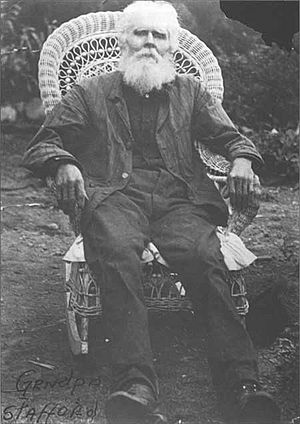Ja Hu Stafford facts for kids
Quick facts for kids
Ja Hu Stafford
|
|
|---|---|
 |
|
| Born |
Jehu Stafford
June 2, 1834 Davidson County, North Carolina, United States
|
| Died | November 14, 1913 |
| Nationality | American |
| Occupation | Frontiersman, soldier, rancher, farmer |
| Known for | Pioneer of Cochise County, Arizona |
Ja Hu Stafford (1834–1913) was an American pioneer who helped settle Cochise County, Arizona. He was known for his adventurous spirit and for building a ranch in a wild part of Arizona.
Contents
Ja Hu's Name
Ja Hu Stafford's name was spelled in many ways. His original name was "Jehu", like a prophet from the Hebrew Bible. Later in his life, he used "Ja Hu". You might also see it as "Jahu" or "J. Hugh". Even today, some of his family prefer to use "Jay Hugh".
Ja Hu's Early Life and Travels
Ja Hu Stafford was born on June 2, 1834. His family lived in Davidson County, North Carolina. When he was young, they moved to Kentucky, then to Missouri. In 1852, Ja Hu joined the United States Army. He spent five years at army posts in the Indian Territory. These included Forts Towson, Arbuckle, and Washita.
After leaving the army, Ja Hu traveled a lot. He went to Texas, Arkansas, and Kansas Territory. He married his first wife, Dorothy Francis Hicks, possibly in Illinois. Then, he moved a small group of cattle to Oregon. He settled near the Powder River to start a ranch and farm.
For seven years, he ran a saloon near Baker, Oregon. He later sold his property and returned to Kansas. He owned many cattle, which he sold to buy land in Garnett, Kansas. After more travels, he eventually moved to Colorado.
New Beginnings in Utah and Arizona
In 1879, Ja Hu was in Manti, Utah. There, he met Christoffer Madsen, a Danish-born Mormon pioneer. Madsen's family had traveled west in a large wagon train. Ja Hu met Madsen's daughter, Pauline Amelia Madsen, who was twelve years old. Family stories say she came to his cabin to warm up after herding cattle.
A few months later, on June 3, 1880, Ja Hu and Pauline became members of the Mormon faith. They likely married around the same time. Soon after, Ja Hu and Pauline left Utah. They wanted to settle in Arizona Territory.
They traveled with a small wagon train. They reached Lee's Ferry on the Colorado River. Ja Hu was good at crossing rivers. He helped the ferry operator get the wagons across safely. For his help, he got a free crossing and one dollar.
Later in 1880, Ja Hu arrived in eastern Sulphur Springs Valley. He stopped at the Riggs Ranch. The owner, Brannick Riggs, suggested Bonita Canyon. This area was in the Chiricahua Mountains. Ja Hu liked the spot. He quickly built a log cabin for the winter. This first cabin was small, about 14 feet by 14 feet. He added another log room later. Around 1898, a small wooden addition was built. Ja Hu officially received his homestead certificate on April 6, 1886. This meant he owned the land.
Life in Bonita Canyon
Ja Hu spent the rest of his life in Bonita Canyon. He raised his family and worked on his ranch and farm. Other people soon joined him. The 10th Cavalry set up a camp there in 1885. Neil Erickson's family settled nearby in 1887.
Ja Hu's garden was very successful. He sold his vegetables to soldiers at Fort Bowie. He also sold them at Camp Bonita and to other settlers. Bonita Canyon was a wild place back then. Geronimo and his group of raiders were still active in the area. There was also a lot of wildlife.
Ja Hu had some exciting animal encounters. Once, he shot a large jaguar that attacked one of his horses. The jaguar was over six feet long! Bobcats also entered his home at least twice. Ja Hu killed them with his knife. He also killed at least one black bear that was threatening his property.
An "Indian Scare"
In 1890, there was an "Indian scare" in Bonita Canyon. An Apache renegade named Massai traveled through the area. Massai had escaped from the army in 1886. He lived on the run in southern Arizona and Mexico.
One day in May 1890, Ja Hu was going to get his horses. He planned to take vegetables to Fort Bowie. Along the trail, he saw a moccasin footprint. Ja Hu quickly returned home to protect his family. Later, when he felt it was safe, he went back to his corral. One of his horses was missing. Massai had stolen it. The army later found the horse and returned it to Ja Hu. Massai escaped into Mexico.
Legacy of Ja Hu Stafford
Ja Hu Stafford passed away in 1913. He was buried next to his wife, Pauline, in the El Dorado Cemetery. Pauline had died earlier in 1894. Ja Hu left behind five children.
Today, Ja Hu's original cabin is called the Stafford Cabin. It is part of the Faraway Ranch Historic District. In 1917, Lillian Erickson Riggs, who owned the nearby Faraway Ranch, bought the Stafford Cabin. She used it as part of her guest ranch business. Later, the cabin was sold to the National Park Service. It became part of the Chiricahua National Monument. The cabin was listed on the National Register of Historic Places in 1975. It was also included as part of the Faraway Ranch Historic District in 1980.
Photo gallery








